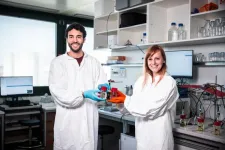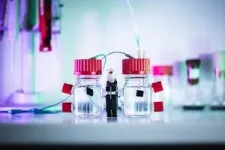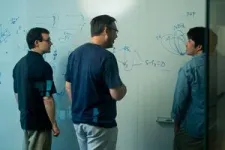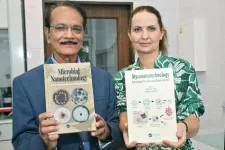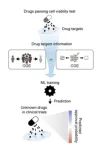Bacteria generate electricity from wastewater
2023-09-08
(Press-News.org)
“We engineered E. coli bacteria, the most widely studied microbe, to generate electricity,” says Professor Ardemis Boghossian at EPFL. “Though there are exotic microbes that naturally produce electricity, they can only do so in the presence of specific chemicals. E. coli can grow on a wide range of sources, which allowed us to produce electricity in a wide range of environments, including from waste water.”
In a paper published in the journal Joule, Boghossian’s team report a groundbreaking achievement in bioelectronics, advancing the capabilities of common E. coli bacteria to generate electricity. The work outlines a novel approach that could revolutionize both waste management and energy production.
E. coli bacteria, a staple of biological research, have been harnessed to create electricity through a process known as extracellular electron transfer (EET). The EPFL researchers engineered E. coli bacteria to exhibit enhanced EET, making them highly efficient “electric microbes.” Unlike previous methods that required specific chemicals for electricity generation, the bioengineered E. coli can produce electricity while metabolizing a variety of organic substrates.
One of the study’s key innovations is the creation of a complete EET pathway within E. coli, a feat not achieved before. By integrating components from Shewanella oneidensis MR-1, a bacterium famous for generating electricity, the researchers successfully constructed an optimized pathway that spans the inner and outer membranes of the cell. This novel pathway surpassed previous partial approaches, and led to a three-fold increase in electrical current generation compared to conventional strategies.
Wastewater as a playground
Importantly, the engineered E. coli exhibited remarkable performance in various environments, including wastewater collected from a brewery. While exotic electric microbes faltered, the modified E. coli thrived, showcasing its potential for large-scale waste treatment and energy production.
“Instead of putting energy into the system to process organic waste, we are producing electricity while processing organic waste at the same time – hitting two birds with one stone!” says Boghossian. “We even tested our technology directly on wastewater that we collected from Les Brasseurs, a local brewery in Lausanne. The exotic electric microbes weren't even able to survive, whereas our bioengineered electric bacteria were able to flourish exponentially by feeding off this waste.”
The implications of the study extend beyond waste treatment. Being abile to generate electricity from a wide range of sources, the engineered E. coli can be utilized in microbial fuel cells, electrosynthesis, and biosensing – to name a few applications. In addition, the bacterium’s genetic flexibility means that it can be tailored to adapt to specific environments and feedstocks, making it a versatile tool for sustainable technology development.
“Our work is quite timely, as engineered bioelectric microbes are pushing the boundaries in more and more real-world applications” says Mouhib, the lead author of the manuscript. “We have set a new record compared to the previous state-of-the-art, which relied only on a partial pathway, and compared to the microbe that was used in one of the biggest papers recently published in the field. With all the current research efforts in the field, we are excited about the future of bioelectric bacteria, and can’t wait for us and others to push this technology into new scales.”
END
ELSE PRESS RELEASES FROM THIS DATE:
2023-09-08
The ability to visualize faces, objects, landscapes, or even scenes from the past exists on a spectrum. While some can picture the layout of a city in minute detail and mentally walk through it, street by street, others have a perfectly blank internal cinema. In this case, we speak of aphantasia—the inability to voluntarily produce the visual mental image corresponding to an idea.
People whose aphantasia is congenital—i.e., not due to a stroke, brain injury, or psychiatric illness—become aware of their peculiarity reasonably ...
2023-09-08
As of today, climate models face the challenge of providing the high-resolution predictions - with quantified uncertainties - needed by a growing number of adaptation planners, from local decision-makers to the private sector, who require detailed assessments of the climate risks they may face locally.
This calls for a step change in the accuracy and usability of climate predictions that, according to the authors of the paper “Harnessing AI and computing to advance climate modelling and prediction”, can ...
2023-09-08
A paper published in the journal Monthly Notices of the Royal Astronomical Society hints at the existence of several black holes in the Hyades cluster — the closest open cluster to our solar system — which would make them the closest black holes to Earth ever detected. The study results from a collaboration between a group of scientists led by Stefano Torniamenti, from the University of Padua (Italy), with the significant participation of with Mark Gieles, ICREA professor at the Faculty of Physics, the ...
2023-09-08
This September 24–29, at the 10th Heidelberg Laureate Forum (HLF), 200 young researchers in mathematics and computer science will spend a week of scientific exchange with the recipients of the disciplines’ most prestigious prizes: the Abel Prize, ACM A.M. Turing Award, ACM Prize in Computing, Fields Medal, the Nevanlinna Prize as well as its continuation, the IMU Abacus Medal. Below are a few highlights of the upcoming program of the HLF as well as a breakdown of how to cover this unique event.
More ...
2023-09-08
Nanoparticles are tiny structures up to 100 nanometers in size. They are characterized by different physical and chemical properties and biological activity than their larger material counterparts. - When the starting material on a micro-scale with a specific surface area is broken down to nano size, i.e. into smaller particles, its surface area will increase many times. And it is the ratio of surface to volume that results in the unique properties of nanoparticles, explains Prof. Mahendra Rai from Sant Gadge Baba Amravati University in India.
Nanoparticles can be mainly ...
2023-09-08
Close relatives of people with metabolic-associated fatty liver disease have a higher risk of developing liver cancer and dying from liver-related diseases, according to a national study from Karolinska Institutet in Sweden published in The Journal of Hepatology. This means that family members could also benefit from the lifestyle advice that is currently only given to patients, the researchers conclude.
People with metabolic-associated fatty liver disease (MASLD, formerly known as NAFLD – see fact box) have an elevated risk of developing and dying from liver cancer. MASLD is now the main reason why the number of people developing liver cancer ...
2023-09-08
A new study has found that air pollution is preventing pollinators finding flowers because it degrades the scent.
A research team comprising the UK Centre for Ecology & Hydrology (UKCEH) and the Universities of Birmingham, Reading, Surrey and Southern Queensland, found that ozone substantially changes the size and scent of floral odour plumes given off by flowers, and that it reduced honeybees' ability to recognise odours by up to 90% from just a few metres away.
Ground-level ozone typically forms when nitrogen oxide emissions from vehicles and industrial processes react with volatile organic compounds emitted from vegetation ...
2023-09-08
LAWRENCE — Many of us know all too well the addictive nature of many foods marketed in the United States — most call it “junk food.” In fact, this kind of salty, sweet and high-fat fare makes up the lion’s share of what’s marketed to Americans.
Researchers employ a more scholarly term for food items featuring purposely tempting combinations of salts, fats and sugars: They’re “hyperpalatable.”
Now, an investigator at the University of Kansas has conducted research showing food brands owned by tobacco ...
2023-09-08
Computer scientists and mathematicians working in complex systems at the University of Sydney and the Max Planck Institute for Mathematics in the Sciences in Germany have developed new methods to describe what many of us take for granted – how easy, or hard, it can be to fall in and out of sync.
Synchronised phenomena are all around us, whether it is human clapping and dancing, or the way fireflies flash, or how our neurons and heart cells interact. However, it is something not fully understood in engineering and science.
Associate Professor Joseph Lizier, expert in complex systems at the University of Sydney, said: “We know ...
2023-09-08
Developing new drugs is paramount in discovering innovative treatments and preventing diseases. This is vital not only for advancing medicine but also for the overall health and well-being of humanity. Yet, even when drugs demonstrate safety and efficacy in cell and animal models, they frequently encounter hurdles in clinical trials on human.
A single setback for a drug during clinical trials, which involves diverse population groups, can result in significant economic losses. To address this, it is imperative to understand why certain drugs, despite passing the preclinical stages, falter during clinical ...
LAST 30 PRESS RELEASES:
[Press-News.org] Bacteria generate electricity from wastewater
